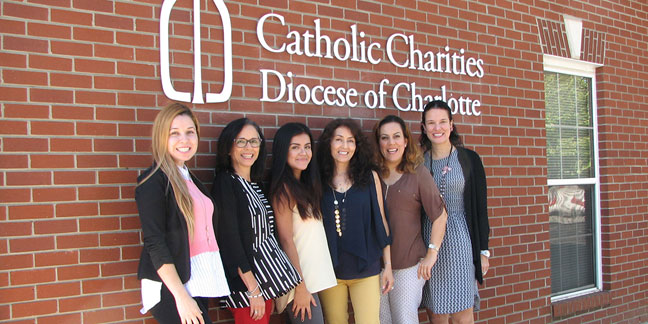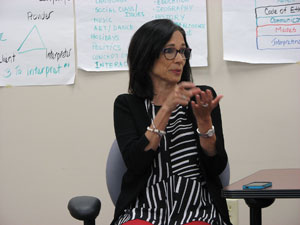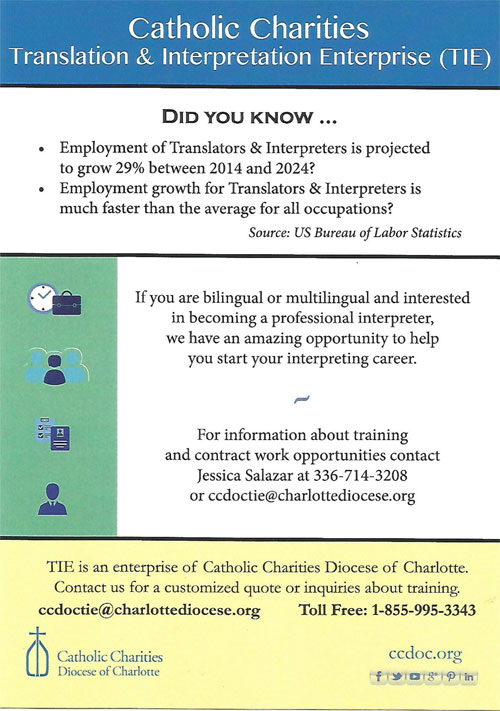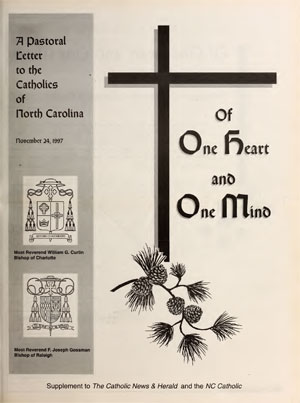 WINSTON-SALEM — The language assistance offered by Catholic Charities Diocese of Charlotte has taken a leap forward.
WINSTON-SALEM — The language assistance offered by Catholic Charities Diocese of Charlotte has taken a leap forward.
After years of offering basic translation of important documents and outsourcing interpretation services, Catholic Charities has expanded its services to educate, train and empower interpreters.
The new language services program – Translation & Interpretation Enterprise, or TIE – has developed its own pool of freelance or contract interpreters and translators and it has started offering services to others. The program now produces income that allows it to be a self-sufficient entity, which can reinvest dollars back into other Catholic Charities services.
Catholic Charities now have a diverse group of clients, and the program continues to grow.
Doctor’s offices, hospitals, government agencies are just some of the many clients now served by the program.
Pictured: With TIE Director Martha Gomez and Translation & Interpretation Coordinator Jessica Salazar are recent TIE students Angely Alvarez, Litzy Joffre, Claudia Zayas and Nathalie Smart. (Photos by Annette K. Tenny | Catholic News Herald)
Language services
Martha Gomez, director of the TIE program, spent many years working in the private sector as a multi-cultural marketer. But she was thrilled when the opportunity arose to launch and direct the TIE program.
“I think since I was a little girl, I wanted to work as an interpreter or as a translator, but life took me down a different road. Now I’ve come back and I’m able to work on this, which fulfills me,” Gomez says.
A lot of time went into determining what would be the framework of the new model and where the best location in the diocese would be, she says. Catholic Charities secured a grant from the Winston-Salem Foundation to help with start-up costs. Catholic Charities of Fort Worth, Texas, a sister agency, was a helpful mentor in designing the new structure, Gomez notes. Since then, it has become a partner in rendering phone services to clients.
Launched in early 2016, the TIE program now has three staff members and a pool of approximately 50 local freelance or contract interpreters and translators. These local contractors can provide vital document translation as well as on-site consecutive interpretation and simultaneous interpretation.
Consecutive interpretation, which is what clients most often request, occurs when a client relays a small amount of information and the interpreter processes that information, then relays it to the person the client is speaking to. This is usually just a thought or two at a time, Gomez says. Simultaneous interpretation occurs with a lag time of just a few seconds.
 For TIE Director Martha Gomez, the language services offered by Catholic Charities are interconnected. They bridge the cultural gap between people, offer training and a professional career path to people who might otherwise struggle to secure an income, and provide high-quality interpretation and translation across the diverse Charlotte diocese. Telephonic interpretation allows the program to offer more than 200 languages and dialects – high demand as well as low demand languages. For example, Gomez says, TIE might receive a request from a client for an interpreter with language skills from the northern region of Vietnam. TIE can contact one of its partner agencies and have a contract interpreter on the phone within minutes.
For TIE Director Martha Gomez, the language services offered by Catholic Charities are interconnected. They bridge the cultural gap between people, offer training and a professional career path to people who might otherwise struggle to secure an income, and provide high-quality interpretation and translation across the diverse Charlotte diocese. Telephonic interpretation allows the program to offer more than 200 languages and dialects – high demand as well as low demand languages. For example, Gomez says, TIE might receive a request from a client for an interpreter with language skills from the northern region of Vietnam. TIE can contact one of its partner agencies and have a contract interpreter on the phone within minutes.
While the majority of requests for on-site interpreters in the Triad area are for Spanish language interpreters, Gomez says, they are starting to see an increase in requests for Arabic and Burmese language interpreters.
They are always looking for more freelancers, Gomez adds, and are beginning to develop a pool of freelancers in the Charlotte area and in the northwestern area of the state.
The business plan for TIE includes a projection to be profitable by its third year of operation, she explains, to be self-sufficient and lead to developing more such “social enterprise” programs within the diocese. So far the rapid growth and development of the TIE program, Gomez says, has been above expectations.
Translating and interpreting are two distinct categories of language services, Gomez explains, and require different skill sets.
To be accepted into TIE’s pool of contractors, applicants must go through a vetting process. Translators are required to take a language proficiency assessment and a written assessment. Interpreters are required to be bilingual or multilingual, take a language proficiency assessment and have formal training (a minimum of 40 hours) in community interpreting from an accredited institution.
If applicants do not have the minimum training required, they can attend TIE’s Introduction to Community Interpreting training course. TIE’s training is accredited for Continuing Education credit and accepted by the Certification Commission for Healthcare Interpreters, which certifies interpreters in the health care setting. The vetting process allows TIE to offer verifiable, high quality services to clients. Much of the work contract translators do involves in-house translation for immigration services, Gomez adds, while the bulk of outside client requests is for interpretation services.
While Gomez stresses the importance of the language services program as a business, she emphasizes that it has been much more than that. Not only does the TIE program strengthen the community by bridging language barriers, it also offers a career path and income for people who are bilingual or multilingual.
“We see a lot of people who have degrees and professions from other countries, but (they) can’t practice here for any number of reasons. They have excellent language skills and we’re offering them the opportunity to use these skills to earn an income,” she says.
Community interpretation training
 Generally, there are two categories of interpretation: legal interpretation, which is state and federally regulated, and community interpretation.
Generally, there are two categories of interpretation: legal interpretation, which is state and federally regulated, and community interpretation.
Community Interpretation is an umbrella term covering law enforcement, education, medical and health services, immigration and social services.
Jessica Salazar, a Mexico native, is the Translation & Interpretation Coordinator. Before coming to TIE, she earned a master’s degree in Interpreting and Translation Studies from Wake Forest University and worked as a professional interpreter for more than 10 years.
“The training we offer here at Catholic Charities is not language specific, which means we train people in interpreting skills,” she explains.
She stresses to her students to stay away from the “he said, she said” format when interpreting. The goal is to relay the information between the client and provider in as conversational a manner as possible, with transparency and accuracy.
Students learn, among other things, how to structure their sessions, how to set the pace so everyone involved in the session is comfortable, and how to process the information the provider relays to the interpreter and then skillfully relay that information to the client.
They are taught how to develop tools to make interpreting sessions more effective, such as note-taking, and they gain practical experience at local health clinics. The classes also teach the students how to secure assignments, manage their workloads and other general business skills. Continuing their education is strongly encouraged.
“Interpreting is definitely a use-it-or-lose-it career. If you’re not up to date on what the expectations are in the industry, you won’t get the assignments,” Salazar notes.
Community colleges and four-year universities offer a wide range of degrees and continuing education classes for Community Interpreters. Professional organizations such as Carolina Association of Translators and Interpreters and the American Association of Translators and Interpreters also offer workshops and online resources. Salazar and Gomez also take the time after training to answer any questions the TIE graduates might have.
“We are very concerned in building a relationship with our interpreters, where they feel we are backing them up as an agency even though we don’t offer them full-time employment,” Salazar says.
Graduates can work for TIE as freelancers as well as take assignments from other agencies.
When students complete their training, they receive a certificate of completion noting that they have completed the minimum 40-hour training most often required from freelance interpreters. There are currently no national, reciprocal or federal standards that are mandated for Community Interpreting. However, the industry and educational institutions are hard at work developing evidence for best practices leading toward such standards.
For its Code of Conduct for Interpreters and Translators, TIE utilizes best practices already generally accepted within the industry. Their strict vetting process and high quality training program assure clients that they will receive professional services.
Recent TIE graduate Litzy Joffre, a native of Mexico, says that before going through the training she saw interpreting mainly as a way to generate income but now also sees another aspect: “Helping people who are limited in English get the services they need, that everybody needs – that should be more recognized as a profession that’s needed.”
For information about becoming a freelance translator or interpreter, go online to www.ccdoc.org/tie or contact Program Coordinator Jessica Salazar at This email address is being protected from spambots. You need JavaScript enabled to view it.. or at 336-714-3208.
— Annette K. Tenny, correspondent

Pastoral letter published 20 years ago still relevant today
 Twenty years ago, Charlotte Bishop William Curlin and Raleigh Bishop Joseph Gossman appealed to their flocks and to all North Carolinians “of good will to reach out to those in dire economic need.”
Twenty years ago, Charlotte Bishop William Curlin and Raleigh Bishop Joseph Gossman appealed to their flocks and to all North Carolinians “of good will to reach out to those in dire economic need.”
In their pastoral letter “Of One Heart and One Mind,” the two bishops discussed the disparity in economic opportunities across North Carolina and invited “Tar Heel Catholics and their neighbors in business, government and the community to ways of ensuring economic justice for everyone.”
The pastoral letter, published in the Catholic News Herald on Nov. 21, 1997, and in the Nov. 23, 1997, edition of Raleigh’s N.C. Catholic, was the first joint pastoral letter by North Carolina’s two Catholic bishops. It expressed urgent concern for the poverty and inequality among North Carolinians and called the local Church to swift and sincere action – action that continues to be needed today.
“... As followers of Jesus Christ our Lord, and as pastoral leaders of the Roman Catholic community in North Carolina, we feel compelled to express our grave concern for the children, women and men in our state who lack sufficient economic means to live full and fruitful lives,” the bishops wrote.
“We are concerned because in the midst of a strong economy there are those among us looking for work who cannot find it; those who need and desire full-time jobs but are limited to part-time or temporary employment; and even among full-time workers a substantial number who fall below subsistence wages and are unable to provide for their family’s basic necessities,” they wrote. “The economic recovery of the last six years has generated a wider income and benefit gulf between the upper and lower ends of our work force. To the working poor, the impact of the expansion has been selective and discriminatory. These economic disparities lead to injustices demanding our attention. We must raise our voices and act to improve and change these conditions.”
“We write to ask you, our sisters and brothers, to embrace with us our Church’s responsibility to help shape our world so that the God-given dignity of every human being will be acknowledged, respected and protected.”
Read: ![]() “Of One Heart and One Mind”
“Of One Heart and One Mind”
“As Catholics, though we are relatively small in number in North Carolina, we have a responsibility to continue to use whatever influence we have to ensure that public policy decisions are more accountable to the common good of all North Carolinians, from the native born to the newly arrived,” they wrote, urging individuals, businesses and organizations to advocate for policies to aid the working poor and all those who find themselves “falling through the cracks.”
The bishops’ pastoral letter prompted the Charlotte diocese to commission the Faith in Action Institute of Greensboro to conduct a study of the needs and assets of the far western region of North Carolina. To implement some of the findings from the study, in 1999 the diocese provided seed funding to establish a Catholic Charities presence in Murphy. Today Catholic Charities offers case management services to people and families in Cherokee, Clay, Graham and Swain counties – offering individualized help based on people’s specific needs, with the aim of helping them move out of poverty.
At a more systemic level, Catholic Charities’ Far West Growing Opportunities Grant Program assists the economic development activities of organizations committed to sustainable economic growth in the region. Since 2000 more than $327,000 in Catholic Charities Growing Opportunities Grants have been dispersed to organizations working in the region, including $16,000 distributed last fall to seven non-profit organizations and ministries combating food insecurity.
But Catholic Charities is eyeing further action as the needs of the population in the region change.
Nearly two decades after the Faith in Action Institute study, the Hinton Rural Life Center in Hayesville partnered with scholars from the University of North Carolina at Greensboro in 2016 to once again consider critical factors influencing local residents’ quality of life. The results of this study, “Enhancing Quality of Life In Southern Appalachia: An Asset Based Community Development Planning Report,” provide priorities and plans for community growth in the region.
The study found that low wages, the lack of good-paying jobs and limited transportation options are keeping people trapped in poverty, and food insecurity, limited access to health care, lack of affordable housing and an increase in substance abuse and mental health problems continue to depress the region. Catholic Charities is evaluating this latest study for ways it can sharpen its focus on helping people in this economically distressed area of the diocese.

